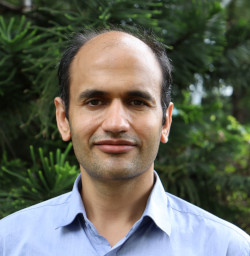Early Career Spotlight Talks
Amos Azaria
Irrational, but Adaptive and Goal Oriented: Humans Interacting with Autonomous Agents
Abstract
Autonomous agents that interact with humans are becoming more and more prominent.
Currently, such agents usually take one of the following approaches for considering human behavior. Some methods assume either a fully cooperative or a zero-sum setting; these assumptions entail that the human’s goals are either identical to that of the agent, or their opposite. In both cases, the agent is not required to explicitly model the human’s goals and account for humans’ adaptation nature.
Other methods first compose a model of human behavior based on observing human actions, and then optimize the agent’s actions based on this model. Such methods do not account for how the human will react to the agent’s actions.
Finally, other methods, such as model free reinforcement learning, merely learn which actions the agent should take at which states. While such methods can, theoretically, account for human adaptation nature, since they require extensive interaction with humans, they usually run in simulation.
By not considering the human’s goals, autonomous agents act selfishly, lack generalization, require vast amounts of data, and cannot account for human’s strategic behavior. Therefore, we present solution concepts for autonomous agents interacting with humans that consider the human’s goals and adaptive nature, and demonstrate their efficiency.

Hau Chan
Analyzing and Designing Strategic Environments in Social Domains
Abstract
The cross-fertilization of AI and economic concepts has led to the advanced development of novel computational ideas. These ideas include models and approaches for analyzing multi-agent interaction (via game-theoretic models and solution concepts) in strategic environments and designing strategic environments (via mechanism design) to address principal decision-making problems involving multi-agent within various social contexts.
In this talk, we will discuss our works on these two main topics. For analyzing multi-agent interaction, we will discuss several computational game-theoretic models to capture various agent characteristics and social (e.g., self-organization) domains. For designing strategic environments, we will discuss principal decision-making mechanism design settings in various social (e.g., facility location) contexts where the principal has to design mechanisms that elicit agent preferences over social outcomes and implement the principal’s desirable social outcomes.

Kai-Wei Chang
Towards Reliable and Inclusive Natural Language Processing
Abstract
Over the past decade, AI techniques have advanced Natural Language Processing (NLP) drastically. Large deep neural networks trained on vast amounts of data have demonstrated impressive performance in many NLP applications with high business value. However, current NLP approaches are often not tolerant to noises (e.g., misspelled words, grammatically incorrect sentences, word replacements with their synonyms, etc.), lack commonsense, exhibit societal biases learned from the data, and do not generalize well for minority users and scenarios. In this paper, I will discuss our research efforts in developing models, algorithms, and learning protocols for fair, inclusive, and robust language processing technology.

Yuxiao Dong
Graph Representation Learning and Pre-Training
Abstract
Graph representation learning has produced promising results in various domains. In this talk, I will introduce our recent progress on how to effectively and efficiently learn representations for graph-structured data. First, we will explore the theoretical equivalence of several popular graph embedding methods, based on which scalable models are developed to handle billion-scale graphs. Second, we will further enable graph representation learning techniques for modeling heterogeneous graphs, whether there exist different types of nodes and edges. The focus will be on how we design the graph neural net (GNN) architecture that can capture the heterogeneous nature of real-world graphs. Finally, we will discuss the strategies of pre-training such GNNs without label supervision. We will show that self-supervised GNNs can outperform dedicated supervised graph learning models across various graph mining tasks in billion-scale graphs, realizing the promise of self-supervised pre-training for graphs.

Ferdinando Fioretto
Integrating Machine Learning and Optimization to Boost Decision Making
Abstract
This talk will present a conceptual review of our recent advancements in the integration of machine learning and optimization. It focuses on describing new hybrid machine learning and optimization methods to predict fast, approximate, solutions to combinatorial problems and to enable structural logical inference. The talk will then discuss some challenges and open questions

Umberto Grandi
Interaction and Expressivity in Collective Decision-Making
Abstract
Collective decisions among human and artificial agents can be enhanced by allowing for more interaction among decision-makers and by letting them express more information about their preferences. In this talk I present ongoing research on two settings: iterative voting, which repeatedly applies a voting rule until decision-makers converge to an outcome, and delegative voting on multiple issues.

Sheng-Jun Huang
Active Learning: Selection Criteria and Query Types
Abstract
In supervised learning, a large set of labeled examples is usually required to train an effective model. However, in many real tasks, the acquisition of labels is difficult and costly, limiting the application of machine learning methods. Active learning, which automatically selects the most valuable data to query their labels, can achieve effective performance with less training data, and thus reduce the labeling cost of human annotators. In active learning, there are two most important components. The first one is the selection criterion, it decides which instances will be selected in the unlabeled set. The second one is the query type, it decides what kind of information will be queried from the oracle for the selected instances. This talk will briefly introduce example progress along these two directions.

Kuldeep S. Meel
Counting, Sampling, and Synthesis: The Quest for Scalability
Abstract
The current generation of automated symbolic reasoning techniques excel at the qualitative tasks (i.e., when the answer is Yes or No) owing to the dramatic progress in satisfiability solving, also referred to as the SAT revolution. The advances in SAT afford us the luxury to focus on quantitative reasoning tasks, whose development is critical to reason about the increasingly interconnected and complex computing systems.
In this talk, I will discuss the design of the next generation of automated reasoning techniques to perform higher-order tasks such as quantification (aka counting), sampling of representative behavior, and automated synthesis of systems. Naturally, these tasks are hard from a complexity-theoretic viewpoint, and therefore, our frameworks focus on tight integration of real-world applications, beyond the worst-case analysis algorithmic design and data-driven system design. This has allowed us to achieve significant advances in counting, sampling, and synthesis, providing a new algorithmic toolbox in formal methods, probabilistic reasoning, databases, and design verification.

Nanyun (Violet) Peng
Controllable Text Generation for Open-Domain Creativity and Fairness
Abstract
Recent advances in large pre-trained language models have demonstrated strong results in generating natural languages and significantly improved performances for many natural language generation (NLG) applications such as machine translation and text summarization. However, when the generation tasks are more open-ended and the content is under-specified, existing techniques struggle to generate long-term coherent and creative content. Moreover, the models exhibit and even amplify social biases that are learned from the training corpora. This happens because the generation models are trained to capture the surface patterns (i.e. sequences of words), instead of capturing underlying semantics and discourse structures, as well as background knowledge including social norms. In this paper, I introduce our recent works on controllable text generation to enhance the creativity and fairness of language generation models. We explore hierarchical generation and constrained decoding, with applications to creative language generation including story, poetry, and figurative languages, and bias mitigation for generation models.

Chao Qian
Towards Theoretically Grounded Evolutionary Learning
Abstract
Machine learning tasks are often formulated as complex optimization problems, where the objective function can be non-differentiable, non-continuous, non-unique, inaccurate, dynamic, and have many local optima, making conventional optimization algorithms fail. Evolutionary Algorithms (EAs), inspired by Darwin’s theory of evolution, are general-purpose randomized heuristic optimization algorithms, mimicking variational reproduction and natural selection. EAs have yielded encouraging outcomes for solving complex optimization problems (e.g., neural architecture search) in machine learning. However, due to the heuristic nature of EAs, most outcomes to date have been empirical and lack theoretical support, encumbering their acceptance to the general machine learning community. In this talk, I will review the progress towards theoretically grounded evolutionary learning, from the aspects of analysis methodology, theoretical perspectives and learning algorithms. Due to time limit, I will include a few representative examples and highlight our contributions. I will also discuss some future challenges.

Adish Singla
TOPS: Machine-Assisted Teaching for Open-Ended Problem Solving
Abstract
Computational thinking and problem solving skills are essential for everyone in the 21st century, both for students to excel in STEM+Computing fields and for adults to thrive in the digital economy. Consequently, educators are putting increasing emphasis on pedagogical tasks in open-ended domains such as programming, conceptual puzzles, and virtual reality environments. When learning to solve such open-ended tasks by themselves, people often struggle. These struggling learners can benefit from individualized assistance, for instance, by receiving personalized curriculum across tasks or feedback within a task. Unfortunately, human tutoring resources are scarce, and receiving individualized human-assistance is rather a privilege. Technology empowered by artificial intelligence has the potential to tackle this scarcity challenge by providing scalable and automated machine-assisted teaching. However, the state-of-the-art technology is limited: it is designed for well-defined procedural learning, but not for open-ended conceptual problem solving. Against this backdrop, I will present our ongoing project, TOPS, on developing next-generation technology for machine-assisted teaching in open-ended domains.

Dengji Zhao
Mechanism Design Powered by Social Interactions: A Call to Arms
Abstract
Mechanism design has traditionally assumed that the participants are fixed and independent. However, in reality, the participants are well-connected (e.g., via their social networks) and we can utilize their connections to power the design. One interesting trend is to incentivize the existing participants to use their connections to invite new participants. This helps to form larger games in auctions, coalitional games, matching etc., which is not achievable with the traditional solutions. The challenge is that the participants are competitors and they would not invite each other by default. Solving this is well-coupled with the existing challenges. For example, in auctions, solving it may require revenue monotonicity and false-name-proofness, which were proved impossible to achieve under certain sensible conditions. In matching, this cannot get along with standard optimality and stability. Hence, we believe there is an important theoretical value to discover and the study will stimulate many interesting applications, especially under decentralized systems with blockchain.

